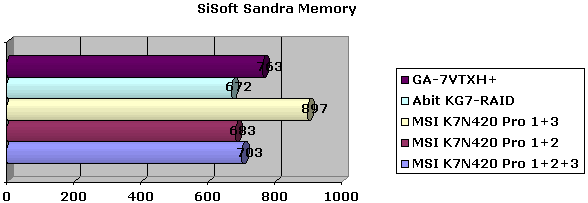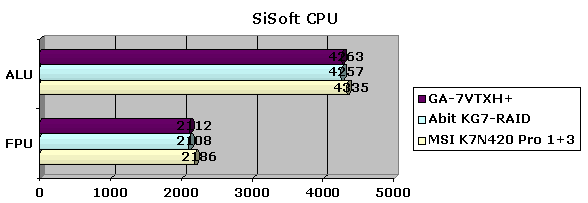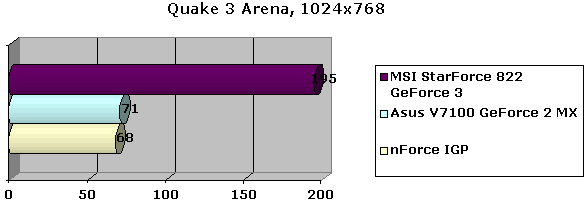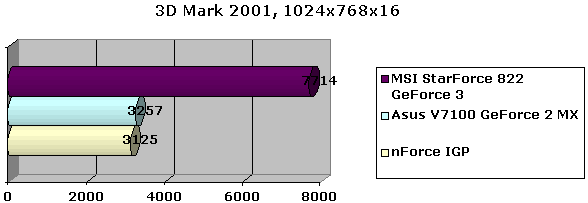|
Benchmarks
Test Bed:
Athlon XP 1800+ (stock speed), 512MB - 768MB (2 or 3 Dimms), MSI K7N420 Pro, IGP/GeForce 2MX, Asus V7100 GeForce 2 MX400, MSI StarForce GeForce 3, Windows XP Professional, Detonator 23.11
Athlon XP 1800+ (stock speed), 512MB (2 Dimms), Abit KG7-RAID, MSI StarForce GeForce 3, Windows XP Professional, Detonator 23.11, VIA 4 in 1 v4.35a - Video not tested
Athlon XP 1800+ (stock speed), 512MB (2 Dimms), Gigabyte GA-7VTXH+ (not yet reviewed), MSI StarForce GeForce 3, Windows XP Professional, Detonator 23.11, VIA 4 in 1 v4.35a - Video not tested

I decided to buck our usual trend around here, and start with the memory benchmarks first. As you can see, there is a significant performance loss when Dimm slot #2 is used in any combination (I only have double sided Dimms to test with). When occupying slots #1 and #3, performance outperforms the KT266A by a fairly large margin. If any other combination is use, performance falls under the KT266A, and barely manages to outperform the AMD760. Although the KG7 is one of the highest performing 760 motherboards, the nForce doesn't leave it too far behind, unless you stick with the two slots that work best. I would imagine that most casual gamers, or consumer users, will likely not have problems since it's not as likely that they will have 3 Dimms (I know plenty of you do).

Nothing terribly remarkable here, as it appears that the CPU is equally fast, regardless of platform. The nForce does out perform everyone else, but you'll be hard pressed to notice it in real world applications.

Quake 3 is great, in that it scales well with video card, CPU, or motherboard changes. We're focussing exclusively on video performance now, and the nForce integrated video seems to perform as advertised. It doesn't deviate too much from the stock GF2 MX, but as expected, can't compete with the GeForce 3.

Nothing new. Move along...

No surprises here.
What we can conclude, in terms of benchmarks, is that the MSI K7N420 Pro is a fast motherboard, and outperforms both the AMD 760 and the KT266A boards we have here in the lair. Video wise, the IGP is more than enough if your needs aren't demanding, but still good enough for all of todays games.
Final Words
The MSI K7N420 Pro is a great performing, and very stable board during testing. So long as I kept my overclocking to 140 FSB or less, things were fine and dandy. For the money, it has great sound, a network interface, extra USB ports (which I neglected to mention earlier), and a decent video solution. Add a high performance board with your own video, sound, and NIC and most likely, you'll be paying more.
On the other hand, although the overall chipset performs well, what if you already got a GeForce 3 and decent sound card? Granted, the nForce has a lot, but it's one of the most expensive motherboards on the market, when compared with competitors such as VIA. I'd gladly trade the sound and video for a RAID option, but it likely won't be for another few weeks, or so, until the nForce 415-D (nForce with no video) is released. Add to the problems, ...a potentially poor performing memory subsystem. It is possible that future BIOS updates may remedy the problem, but IIRC, the memory issue will likely not ever be fixed. I should point out that this "flaw" is buy design, and although performance suffers, the board remains stable. It's nice nVidia thought about stability, but I'd wish there was an option in the BIOS for you to decide whether the performance lost by Superstaility mode is worth it.
Despite the high price of the board, anyone on a budget, and/or who needs to build a system from the ground up, should consider the MSI K7N420 Pro. Buy a case, CPU, ram and disk drives and you're set. Even those of you AMD fun-boyz, who are migrating from SDRAM to DDR, may want to give this board a look. Who knows, the integrated stuff may even be better than what you already own. If you already got a DDR solution though, and a decent video, and/or sound solution,... you might want to wait for the manufacturers' next product cycle.
MSI:
Pros: Very fast, stable, integrated components that don't suck! Alot for your money.
Cons: Memory performance issues with various ram types. Questionable value for anyone with Post-GeForce 2 video and modern DDR systems.
Agree? Disagree? Discuss it in our forums.
Previous Page - BIOS and Overclocking
Home
|
